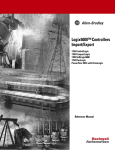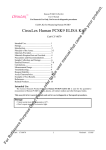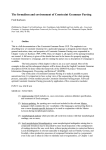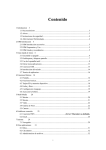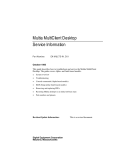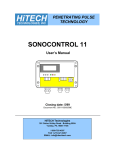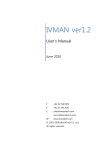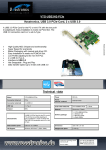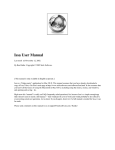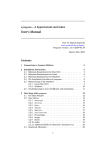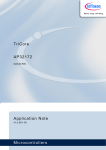Download ACOPOST: User manual
Transcript
ACOPOST: User manual Version 1.8.4 Ingo Schrder [email protected] Contents Contents 1 1 Introduction 3 2 Installation 3 3 File formats 4 4 Tutorial 5 5 Program references 5 5.1 complementary-rate.pl 5.1.1 Purpose . . . . 5.1.2 Usage . . . . . 5.1.3 Example . . . . 5.2 cooked2lex.pl . . . . . 5.2.1 Purpose . . . . 5.2.2 Usage . . . . . 5.2.3 Example . . . . 5.3 cooked2ngram.pl . . . 5.3.1 Purpose . . . . 5.3.2 Usage . . . . . 5.3.3 Example . . . . 5.4 cooked2tt.pl . . . . . . 5.4.1 Purpose . . . . 5.4.2 Usage . . . . . . . . . . . . . . . . . . . . . . . . . . . . . . . . . . . . . . . . . . . . . . . . . . . . . . . . . . . . . . . . . . . . . . . . . . . . . . . . . . . . . . . . . . . . . . . . . . . . . . . . . . . . . . . . . . . . . . . . . . . . . . . . . . . . . . . . . . . . . . . . . . . . . . . . . . . . . . . . . . . . . . . . . . 1 . . . . . . . . . . . . . . . . . . . . . . . . . . . . . . . . . . . . . . . . . . . . . . . . . . . . . . . . . . . . . . . . . . . . . . . . . . . . . . . . . . . . . . . . . . . . . . . . . . . . . . . . . . . . . . . . . . . . . . . . . . . . . . . . . . . . . . . . . . . . . . . . . . . . . . . . . . . . . . . . . . . . . . . . . . . . . . . . . . . . . . . . . . . . . . . . . . . . . . . . . . . . . . . . . . . . . . . . . . . . . . . . . . . . . . . . . . . . . . . . . . . . . . . . . . . . . . . . . . . . . . . . . . . . . . . . . . . . . . . . . . . . . . . . . . . . . . . . . . . . . . . . . . . . . . . . . . . . . . . . . . . . . . . . . . . . . . . . . . . . . . . . . . . . . . . . . . . . . . . . . . . . . . . . . . . . . . . 6 6 6 6 6 6 6 6 7 7 7 7 7 7 7 5.5 5.6 5.7 5.8 5.9 5.10 5.11 5.12 5.4.3 Example . cooked2wsj.pl . . 5.5.1 Purpose . 5.5.2 Usage . . 5.5.3 Example . cooked2wtree.pl . 5.6.1 Purpose . 5.6.2 Usage . . 5.6.3 Features . 5.6.4 Example . et . . . . . . . . . 5.7.1 Purpose . 5.7.2 Usage . . 5.7.3 Example . evaluate.pl . . . . 5.8.1 Purpose . 5.8.2 Usage . . 5.8.3 Example . majority-voter.pl 5.9.1 Purpose . 5.9.2 Usage . . 5.9.3 Example . met . . . . . . . 5.10.1 Purpose . 5.10.2 Usage . . 5.10.3 Example . t3 . . . . . . . . 5.11.1 Purpose . 5.11.2 Usage . . 5.11.3 Example . tbt . . . . . . . . . . . . . . . . . . . . . . . . . . . . . . . . . . . . . . . . . . . . . . . . . . . . . . . . . . . . . . . . . . . . . . . . . . . . . . . . . . . . . . . . . . . . . . . . . . . . . . . . . . . . . . . . . . . . . . . . . . . . . . . . . . . . . . . . . . . . . . . . . . . . . . . . . . . . . . . . . . . . . . . . . . . . . . . . . . . . . . . . . . . . . . . . . . . . . . . . . . . . . . . . . . . . . . . . . . . . . . . . . . . . . . . . . . . . . . . . . . . . . . . . . . . . . . . . . . . . . . . . . . . . . . . . . . . . . . . . . . . . . . . . . . . . . . . . . . . . . . . . . . . . . . . . . . . . . . . . . . . . . . . . . . . . . . . . . . . . . . . . . . . . . . . . . . . . . . . . . . . . . . . . . . . . . . . . . . . . . . . . . . . . . . . . . . . . . . . . . . . . . . . . . . . . . . . . . . . . . . . . . . . . . . . . . . . . . . . . . . 2 . . . . . . . . . . . . . . . . . . . . . . . . . . . . . . . . . . . . . . . . . . . . . . . . . . . . . . . . . . . . . . . . . . . . . . . . . . . . . . . . . . . . . . . . . . . . . . . . . . . . . . . . . . . . . . . . . . . . . . . . . . . . . . . . . . . . . . . . . . . . . . . . . . . . . . . . . . . . . . . . . . . . . . . . . . . . . . . . . . . . . . . . . . . . . . . . . . . . . . . . . . . . . . . . . . . . . . . . . . . . . . . . . . . . . . . . . . . . . . . . . . . . . . . . . . . . . . . . . . . . . . . . . . . . . . . . . . . . . . . . . . . . . . . . . . . . . . . . . . . . . . . . . . . . . . . . . . . . . . . . . . . . . . . . . . . . . . . . . . . . . . . . . . . . . . . . . . . . . . . . . . . . . . . . . . . . . . . . . . . . . . . . . . . . . . . . . . . . . . . . . . . . . . . . . . . . . . . . . . . . . . . . . . . . . . . . . . . . . . . . . . . . . . . . . . . . . . . . . . . . . . . . . . . . . . . . . . . . . . . . . . . . . . . . . . . . . . . . . . . . . . . . . . . . . . . . . . . . . . . . . . . . . . . . . . . . . . . . . . . . . . . . . . . . . . . . . . . . . . . . . . . . . . . . . . . . . . . . . . . . . . . . . . . . . . . . . . . . . . . . . . . . . . . . . . . . . . . . . . . . . . . . . . . . . . . . . . . . . . . . . . . . . . . . . . . . . . . . . . . . . . . . . . . . . . . . . . . . . . . . . . . . . . . . . . . . . . . . . . . . . . . . . . . . . . . . . . . . . . . . . . . . . . . . . . . . . . . . . . . . . . . . . . . . . . . . . . . . . . . . . . . . . . . . . . . . . . . 7 8 8 8 8 8 8 8 9 9 9 9 10 10 10 10 10 11 11 11 11 11 11 11 12 12 12 12 12 13 13 5.12.1 Purpose . 5.12.2 Usage . . 5.12.3 Templates 5.12.4 Example . 5.13 tt2cooked.pl . . . 5.13.1 Purpose . 5.13.2 Usage . . 5.13.3 Example . 5.14 wsj2cooked.pl . . 5.14.1 Purpose . 5.14.2 Usage . . 5.14.3 Example . . . . . . . . . . . . . . . . . . . . . . . . . . . . . . . . . . . . . . . . . . . . . . . . . . . . . . . . . . . . . . . . . . . . . . . . . . . . . . . . . . . . . . . . . . . . . . . . . . . . . . . . . . . . . . . . . . . . . . . . . . . . . . . . . . . . . . . . . . . . . . . . . . . . . . . . . . . . . . . . . . . . . . . . . . . . . . . . . . . . . . . . . . . . . . . . . . . . . . . . . . . . . . . . . . . . . . . . . . . . . . . . . . . . . . . . . . . . . . . . . . . . . . . . . . . . . . . . . . . . . . . . . . . . . . . . . . . . . . . . . . . . . . . . . . . . . . . . . . . . . . . . . . . . . . . . . . . . . . . . . . . . . . . . . . . . . . . . . . . . . . . . . . . . . . . . . . . . . . . . . . . . . . . . . . . . . . . . . . . . . . . . . . . . . . . . . . . . . . . . . . . . . . . . . . . . . . . . . . . . . . . . . . . . . . . . . . . . . . . . . . . . . . . . . . . . . . . . . References . . . . . . . . . . . . 13 14 14 15 15 15 15 15 15 15 15 16 16 1 Introduction This document describes how to use the ACOPOST program suite. ACOPOST is a collection of part-of-speech tagging algorithms, each originating from a dierent machine learning paradigm. t3 is a trigram tagger based on Markov models. met is a maximum entropy inspired tagger. tbt is an error-driven learner of transformation rules. et is an example-based tagger. An evaluation of the individual part-of-speech taggers and of novel combination techniques can be found in an accompanying technical report [Sch02]. 2 Installation ACOPOST is available under the GNU public license1 from the project homepage hosted at //www.sourceforge.net. 1 See http://www.gnu.org/licenses/gpl.html. 3 http: ACOPOST comes as a gzipped tar archive of the source code named acopost-x:y:z .tar.gz where x:y:z is the version number. No pre-compiiled binaries are available but don't worry: Compiling is easy. You only need a C compiler (gcc is recommended) and the make program which are both most probably already installed on your machine if you're using UNIX.2 Some scripts use the Perl programming language3 which you want to have installed anyway. Find a convenient place in your directory tree and unzip the archive which unpacks into a new directory acopost-x:y:z : PROMPT: gunzip -c acopost-1.8.4.tar.gz | tar fxv acopost-1.8.4/ acopost-1.8.4/src/ acopost-1.8.4/src/Makefile acopost-1.8.4/src/array.c ... The fresh directory contains at least the following les and directories: Text le README with a short intro and latest changes. Directory bin which contains the Perl scripts and where the binaries are installed after compilation. Directory src which contains the C les. Directory docs which contains the documentation, this user guide and a technical report [Sch02]. Directory examples which contains some example les. To compile, change to the src directory and type make. If everything works out ok, issue the command make install which installs the binaries into the directory ../bin. Congratulations! You're done. If something goes wrong, try to x it by adpating the Makefile or the source code. Don't forget to tell me about your problems so that I can provide a better solution with the next release. You can now chose to add the bin directory as a full path to your PATH variable, to move/copy all binaries from the bin directory to a directory already in your PATH variable or simply decide to always use the full path to an ACOPOST program. 3 File formats I tried to keep everything as simple as possible in order to be able to use other tools on the corpora, e.g., UNIX tools like grep, sed, wc etc. or Perl. Therefore, I chose line-based formats for the corpora, i.e., each line of texts (separated by the newline character \n) holds exactly one sentence. The items 2 3 I have not tried to compile ACOPOST on MS Windows but I am interested in reports from Windows users. See http://www.perl.org/ and http://www.perl.com/. 4 in a sentence are separated by one or more white space characters, i.e., tabular \t or space characters. Punctuation marks should be separated from preceding words. ACOPOST uses two le formats for text: raw and cooked. Raw text follows the line-based format described above but doesn't contain any additional information. Here's an example from the Wall Street Journal corpus [MSM93]: The rest went to investors from France and Hong Kong . Cooked text contains the part-of-speech tags for the words. The tag immediately follows the word and the two are separated by one or more white space characters, i.e., in the same way ajacent words are separated. Of course, a line of cooked text must always contain an even number of items. Here's the same example as above as cooked text: The DT rest NN went VBD to TO investors NNS from IN France NNP and CC Hong NNP Kong NNP . . Note that the period functions as both a word and a tag symbol in the Wall Street Journal corpus. The ACOPOST program suite contains Perl scripts which convert from and into dierent formats, e.g., wsj2cooked.pl (cf. Section 5.14), tt2cooked.pl (cf. Section 5.13) and cooked2tt.pl (cf. Section 5.4). The individual taggers use additional data formats to store the model information. These formats have been chosen to be human-readable but completely understanding them requires deep insights into the tagging algorithms. The formats of model le might change between releases. The format of the lexicon les is also line-based. Each line lists the word form and the possible tags including the tag counts. WORDFORM TAG1 TAGCOUNT1 TAG2 TAGCOUNT2 ... An older format allowed for an optional word count after the word form but since this information is redundant it is deprecated. 4 Tutorial Nothing yet. 5 Program references Note that not all programs in the bin directory are described here. This may be the case due to one of the following reasons. The program is considered to be of marginal importance. It hasn't reached a stable state. It's obsolete. 5 5.1 complementary-rate.pl 5.1.1 Purpose Report the complementary error rate [BW98] of two versions of a tagged corpus. 5.1.2 Usage complementary-rate.pl [-h] ref a b -h ref a b display short help text and exit reference corpus in cooked format rst tagged corpus in cooked format second tagged corpus in cooked format 5.1.3 Example PROMPT: ~/acopost/bin/complementary-rate.pl 0.ref 0.t3 0.tnt accuracy A 96.221% 16651 654 0 accuracy B 96.689% 16732 573 comp(A,B) 22.783% 505 654 comp(B,A) 11.867% 505 573 PROMPT: 5.2 cooked2lex.pl 5.2.1 Purpose Convert a corpus in cooked format to a lexicon. 5.2.2 Usage cooked2lex.pl [-h] [-c] < in.cooked > out.lex -h -c display a short help text and exit output deprecated word count after the word form (cf. Section 3) 5.2.3 Example PROMPT: cooked2lex.pl < negra.cooked > negra.lex 20602 sentences 55 tags 51272 types 355096 tokens 1 49189 95.937% 238545 67.178% 2 1884 3.675% 45586 12.838% 6 3 164 0.320% 4 32 0.062% 5 1 0.002% 6 1 0.002% 7 1 0.002% Mean ambiguity A=1.611544 46789 20090 2715 1363 8 13.176% 5.658% 0.765% 0.384% 0.002% Entropy H(p)=4.273873 PROMPT: 5.3 cooked2ngram.pl 5.3.1 Purpose Convert a corpus in cooked format to a le containing counts for tag n-grams. 5.3.2 Usage cooked2ngram.pl [-h] < in.cooked > out.ngram -h display a short help text and exit 5.3.3 Example PROMPT: cooked2ngram.pl < corpus.cooked > corpus.ngram 5.4 cooked2tt.pl 5.4.1 Purpose Convert a corpus in cooked format to a corpus in the format [Bra97] used by the TnT tagger package [Bra00]. 5.4.2 Usage cooked2tt.pl [-h] < in.cooked > out.tt -h display a short help text and exit 5.4.3 Example PROMPT: cooked2tt.pl < negra.cooked > negra.tt 20602 sentences PROMPT: 7 5.5 cooked2wsj.pl 5.5.1 Purpose Convert a corpus in cooked format to a corpus in the format used by the Wall Street Journal corpus [MSM93]. 5.5.2 Usage cooked2wsj.pl [-h] < in.cooked > out.wsj -h display a short help text and exit 5.5.3 Example PROMPT: PROMPT: 5.6 cooked2wtree.pl 5.6.1 Purpose Convert a corpus in cooked format to a weighted tree [DvdBW97, Sch02] for use in example-based disambiguation. Warning: the current implementation is far from ecient. Training on the Wall Street Journal corpus requires large amounts of main memory. Be careful! 5.6.2 Usage cooked2wtree.pl OPTIONS f-file < in.cooked > out.wsj where f-file is a feature le (see below) and OPTIONS can be one or more of: -a a is the minimal word count that a word must have to be considered (default: unlimited) -b b is the maximal word count that a word must have to be considered (default: unlimited) -d debug ag -e e le with tags to be excluded (default: exclude none) -i i le with tags to be explicitely included (default: include all) -h display a short help text and exit -r r rare word count threshold -w w word rank threshold (default: 100) 8 5.6.3 Features Features describe characteristics of tagging context that can be used for the tagging decision. The following features are allowed: TAG[relpos ]: Include the tag at the relative position relpos as a criterion for the decision. For example, TAG[-1] means the tag of the word immediately to the left. Of course, relpos must be negative since the tags to the right are not yet known. CLASS[relpos ]: Use the ambiguity class at the relative position relpos as a criterion. For example, CLASS[1] considers the ambiguity class of the word to the right of the current word. WORD[relpos ]: Use the word form at the relative position relpos as a criterion. Note that only frequent words (see options -r and -w) are used. For rare words the artical token *RARE* is substituted. LETTER[relpos, index ]: Use the letter at position index of the word at the relative position relpos as a criterion. Negative values of index count from the end of the word backwards. CAP[relpos ]: Use the binary answer whether the word at the relative position relpos is capitatized as a criterion. HYPHEN[relpos ]: Use the binary answer whether the word at the relative position relpos contains a hyphen as a criterion. NUMBER[relpos ]: Use the binary answer whether the word at the relative position relpos contains a digit as a criterion. INTER[relpos ]: Use the binary answer whether the word at the relative position relpos contains an interpunctuation mark as a criterion. The directory examples/et contains example feature les. 5.6.4 Example PROMPT: PROMPT: 5.7 et 5.7.1 Purpose Assign tags to a natural language text in raw format using the example-based paradigm [Sch02, Section 5.4]. Note that the learning phase is done by the Perl script cooked2wtree.pl (cf. Section 5.6). 9 5.7.2 Usage et OPTIONS knownwtree unknownwtree lexiconfile [in.raw] > out.cooked where knowntree is a weighted tree le generated by cooked2wtree.pl (cf. Section 5.6) for known words, unknowntree is a weighted tree le for unknown words and lexiconfile is a lexicon le generated by cooked2lex.pl (cf. Section 5.2). If the input le in.raw is omitted standard input is used. OPTIONS can be: -v v verbosity (default: 1) 5.7.3 Example PROMPT: cooked2lex.pl < train.cooked > train.lex ... PROMPT: cooked2wtree.pl -a 3 known.etf < train.cooked > known.wtree ... PROMPT: cooked2wtree.pl -b 2 unknown.etf -e closed-class-tags < train.cooked > unknown.wtree ... PROMPT: et known.wtree unknown.wtree train.lex < test.raw > test.et [ 0 ms::1] [ 0 ms::1] Example-based Tagger (c) Ingo Schrder, [email protected] [ 0 ms::1] [ 2240 ms::1] read wtree with 156173 nodes from "known.wtree" [ 3580 ms::1] read wtree with 116334 nodes from "unknown.wtree" [ 3590 ms::1] done PROMPT: evaluate.pl test.cooked test.et 2060 sentences test.et 33990 1434 95.952% 5.8 evaluate.pl 5.8.1 Purpose Report tagging accuracy on sentence level, for unknown, known and all words. 5.8.2 Usage [-h] [[-i] -l l] [-v] ref t1 ... display short help text and exit use case-insensitive lexicon use lexicon l be verbose reference corpus in cooked format tagged corpus in cooked format evaluate.pl -h -i -l l -v ref t1 10 5.8.3 Example PROMPT: evaluate.pl 0.ref 0.t3 0.tnt 1002 sentences 0.t3 16651 654 0.tnt 16732 573 PROMPT: 96.221% 96.689% 5.9 majority-voter.pl 5.9.1 Purpose Report how often dierent numbers of dierent taggers have tagged words correctly. See (author?) [Sch02]. This immediately tells one how ecient a parallel combination of dierent taggers can be. Four numbers are given in each line: The number of taggers that were correct, the percentage of words, the accumulated percentage of words and the mean ambiguity of tags if all emitted tags are counted. 5.9.2 Usage [-h] ref t1 t2 ... display short help text and exit reference corpus in cooked format rst tagged corpus in cooked format second tagged corpus in cooked format majority-voter.pl -h ref t1 t2 5.9.3 Example PROMPT: majority-voter.pl 0.ref 0.t3 0.tbt 0.et 0.met 2061 sentences 35674 words 4: 92.928% 92.928% 0.937658 3: 3.493% 96.420% 0.983041 2: 1.343% 97.763% 1.010988 1: 1.090% 98.854% 1.068313 0: 1.146% 100.000% PROMPT: 5.10 met 5.10.1 Purpose Nothing yet. 11 5.10.2 Usage met OPTIONS modelfile [inputfile] where modelfile is a trained or a new model le and inputfile is either a corpus in cooked format (for training) or in raw format (for tagging). OPTIONS can be one or more of the following: -b b beam factor (default: 1000) for viterbi search or n-best width (default: 5) for n-best search -c c command mode, "tag", "train" or "test" -d d dictionary le -f f threshold for feature count (default: 5) -h display short help and exit -i i maximum number of iterations (default: 100), training only -m m probability threshold (default: 1.0) -n use n-best instead of viterbi -p p UNIX priority class (default: 19) -r r rare word threshold (defualt: 5) -s case sensitive dictionary -t t minimum accuracy improvement per iteration (default: 0.0), training only -v v verbosity (default: 1) 5.10.3 Example PROMPT: met -c test -d train.lex train.model.met < test.cooked [ 0 ms::1] running as test [ 0 ms::1] using test.lex as dictionary file [ 1390 ms::1] read 54 tags, 40690 predicates and 83343 features [ 2090 ms::1] read 45779 lexicon entries, discarded 2237 entries [ 24620 ms::1] 35674 (35257 pos 417 neg) words tagged, accuracy 98.831% PROMPT: 5.11 t3 5.11.1 Purpose Assign tags to a natural language text in raw format using the Viterbi algorithm based on a hidden Markov model (HMM). The model information is extracted from a tag trigram le and a lexicon le. Note that the learning phase is very easy for HMMs. For that reason, the training phase is done by the Perl script cooked2ngramn.pl (cf. Section 5.3). 5.11.2 Usage t3 OPTIONS modelfile lexiconfile [in.raw] > out.cooked where modelfile is a tag trigram le generated by cooked2ngram.pl (cf. Section 5.3) and lexiconfile is a lexicon le generated by cooked2lex.pl (cf. Section 5.2). If the input le in.raw is omitted standard input is used. OPTIONS can be: 12 -a a -b b -d -h -l -m -q -r -s l m r s -t -u -v v -x -y -z smoothing parameters for transitional probabilities, see (author?) [Sch02, Section 5.1.1] and (author?) [Bra00] for the default beam factor (default: 1000), states that are worse by this factor or more than the best state at this time point are discarded debug mode display short help and exit maximum sux length for estimating output probability for unknown words (default: 10) mode of operation (default: 0): 0 means tagging, 1 testing, ... quiet mode of operation rare word count (default: 1) (for output probabilities) theta for sux backo (default: SD of tag probabilities), see (author?) [Sch02, Section 5.1.1] and (author?) [Bra00] test mode (reads cooked input) use line-buered IO for input (default: block-buered on les) verbosity (default: 1) case-insensitive sux tries (default: sensitive) case-insensitive when branching in sux trie (default: sensitive) use zero probability for unseen transition probabilities (default: 1/#tags) 5.11.3 Example PROMPT: cooked2lex.pl < train.cooked > train.lex ... PROMPT: cooked2ngram.pl < train.cooked > train.ngram ... PROMPT: t3 train.ngram train.lex < test.raw > test.t3 [ 0 ms::1] [ 0 ms::1] Trigram POS Tagger (c) Ingo Schrder, [email protected] [ 0 ms::1] [ 80 ms::1] model generated from 18541 sentences (thereof 491 one-word) [ 80 ms::1] found 55623 uni-, 74164 bi-, and 92214 trigram counts for the boundary tag [ 210 ms::1] computed smoothed transition probabilities [ 1940 ms::1] built suffix tries with 32602 lowercase and 74242 uppercase nodes [ 1970 ms::1] leaves/single/total LC: 8628 20073 32603 [ 2040 ms::1] leaves/single/total UC: 18627 47180 74243 [ 4420 ms::1] suffix probabilities smoothing done [theta 7.489e-02] [ 21690 ms::1] done PROMPT: evaluate.pl test.cooked test.t3 2061 sentences test.t3 34547 1127 96.841% 5.12 tbt 5.12.1 Purpose Nothing yet. 13 5.12.2 Usage tbt OPTIONS rulefile [inputfile] -i -l -m -n -o -p -r -t -u -v i l m n o p t u v maximum number of training iterations (default: unlimited), training only lexicon le (default: none) minimum improvement per training iteration (default: 1), training only rare wore threshold (default: 0) mode of operation (default: 0): 0 tagging, 1 testing, 2 training preload le (default: lexically most probable tag), start from a dierent initial tagging assume raw format for input (default: cooked format), tagging only template le (default: none), training only, see below unknown word default tag (default: most probable tag from lexicon) verbosity (defualt: 1) 5.12.3 Templates Templates are patterns for rules. The le format is line-based, i. e., one rule per line, empty lines and everything after a hash sign # is ignored. The format for a rule or template is as follows: TARGETTAG CONDITION1 CONDITION2 ... where TARGETTAG is the new tag for the word under consideration and the conditions are prerequisites for the application of the rule. All conditions must be fullled for a rule to trigger. The following types of conditions are allowed: tag[relpos ]=tag The current tag of the word at relative position relpos is tag. bos[relpos ] Begin of sentence marker at relative position relpos. eos[relpos ] End of sentence marker at relative position relpos. word[relpos ]=word The word at relative position relpos is word. rare[relpos ] The word at relative position relpos is rare. prefix[length ]=prex The prex of length length of the current word is prex. suffix[length ]=sux The sux of length length of the current word is sux. cap[relpos ]=mode The capitilization of the word at relative position relpos is as mode which can be: no No character is capitilized. some Some characters are capitilized. all All characters are capitilized. digit[relpos ]=mode The word at relative position relpos contains digits according to mode which can be no, some or all (see cap) The placeholders tag, word, prex, sux and mode can also be the wildcard symbol * in templates. A typical rule template which takes the two preceding tags into account would then be: * tag[-2]=* tag[-1]=* The examples/tbt directory contains example template les. 14 5.12.4 Example PROMPT: cat train.rules $. rare[0] NN rare[0] digit[0]=no ADJA rare[0] tag[0]=NN cap[0]=no VVPP rare[0] tag[0]=ADJA suffix[0]=t ... PROMPT: tbt -r -l train.lex train.rules < test.raw > test.tbt Transformation-based Tagger (c) Ingo Schrder, [email protected] done PROMPT: evaluate.pl test.cooked test.tbt 2061 sentences test.tbt 34430 1244 96.513% 5.13 tt2cooked.pl 5.13.1 Purpose Convert a corpus in a format [Bra97] used by the TnT tagger package [Bra00] to a corpus in cooked format. 5.13.2 Usage tt2cooked.pl [-h] < in.tt > out.cooked -h display a short help text and exit 5.13.3 Example PROMPT: tt2cooked.pl < negra.tt > negra.cooked 396309 lines read PROMPT: 5.14 wsj2cooked.pl 5.14.1 Purpose Convert a corpus in Wall Street Journal format to cooked format. 5.14.2 Usage wsj2cooked.pl < in.wsj > out.cooked 15 5.14.3 Example PROMPT: wsj2cooked.pl < corpus.wsj > negra.cooked PROMPT: References [Bra97] Thorsten Brants. The negra export format for annotated corpora (version 3), 1997. [Bra00] Thorsten Brants. TnT - a statistical part-of-speech tagger. In Proceedings of the Sixth Applied Natural Language Processing Conference (ANLP-2000), Seattle, WA, USA, 2000. [BW98] Eric Brill and Jun Wu. Classier combination for improved lexical disambiguation. In Proc. Joint Conference COLING/ACL '98, pages 191{195, Montral, Canada, 1998. [DvdBW97] Walter Daelemans, Antal van den Bosch, and Ton Weijters. Igtree: Using trees for compression and classication in lazy learning algorithms. Articial Intelligence Review, 11:407{423, 1997. [MSM93] M. Marcus, B. Santorini, and M. Marcinkiewicz. Building a large annotated corpus of English: the Penn Treebank. Computational Linguistics, 19(2), 1993. [Sch02] Ingo Schrder. A case study in part-of-speech tagging using the ICOPOST toolkit. Technical report, Computer Science, University of Hamburg, 2002. 16

















